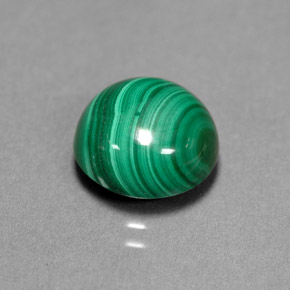The Gemstone Malachite

Malachite is a deep green opaque gemstone with parallel bands and concentric rings, giving it a unique appearance. Its significance dates back to the ancient Egyptian and Greek civilizations, and its use has been important throughout the centuries. The famous Russian Malachite deposits were historically worked for use as a gemstone and carving stone, with Malachite being especially used in the house of the Russian Czars.
Chemical Formula
?
Cu
2CO
3(OH)
2
Mineral Class
?
Malachite
Additional Properties
|
Refractive Index
?
1.65 - 1.91 |
Double Refraction
?
-.025 |
Transparency
?
Opaque |
SG
?
3.9 - 4.0 |
Luster
?
Silky |
| Cleavage ?
1,1 - basal. Not usually discernible because crystals are tiny. |
All About
Despite its very low
hardness and lack of durability, Malachite remains a popular green gemstone due to its unique and desirable color habit. Most of the Malachite gemstones have
banding or vein-like color patterns; solid-color gems are not commonly available due to their lack of interest. The most desirable pattern in Malachite is rounded
concentric eye-like rings.
Malachite has historically been worn as a healing gemstone. It was used as a protection against the evil eye and given to children to wear to protect them from having nightmares. Even today there are people who use Malachite as a gemstone for holistic and spiritual purposes.
The Winter Palace landmark of St. Petersburg, Russia, contains one of the most outstanding displays of this gemstone in a room called the Malachite Room. This room, designed in the late 1830's, includes a fireplace, large columns, urns, and decorative vases made entirely of Russian Malachite. It was designed as a formal reception room for Russian Empress Alexandra Fyodorovna, wife of Czar Nicholas I, and used as her drawing-room as well as a gathering place for the Imperial family for official functions.
Due to its relative availability in copper deposits today, Malachite has become inexpensive and easily obtainable. Malachite sometimes forms together with blue
Azurite, and this contrasting blue and green formation of both these minerals is known as
Azure-Malachite.
Uses
?
Malachite is used mostly as a bead gemstone for necklaces and bracelets.
Cabochons are occasionally also cut, and these may be in various jewelry forms including pendants. Due to its softness and patterns, Malachite is a popular carving gemstone, with animal carvings and ornate small boxes and bowls carved out of it.
Treatments & Enhancements
?
Malachite is generally not treated or enhanced.
Malachite Sources
?
Malachite is found worldwide, and is especially prevalent in copper-producing regions. However, the thick
banded type used for gemstones is far less common then the typical formation habits. One of the original sources, from which ornaments and jewelry were made since very early times, was Yekaterinburg Oblast (Sverdlovsk)
in the Ural Mountains of Russia. Currently the largest producer of gem Malachite is the Congo (Zaire), where outstanding banded material comes from the vast deposits of the Katanga (Shaba) copper belt. This area produces almost all of the gemstone Malachite on the market today. Other important Malachite deposits are in Australia, China, Chile, and the United States (Arizona).
Similar Gemstones
?
Due to the unique color and
habits of Malachite, as well as its low
hardness, it is easily distinguished from other gemstones.
Malachite in the Rough Photos
?